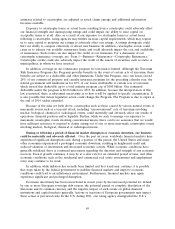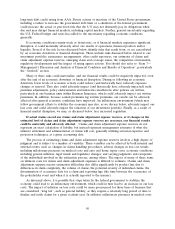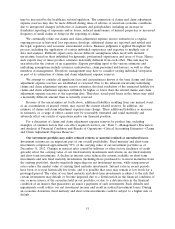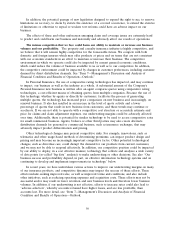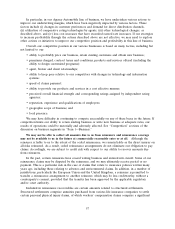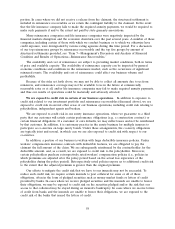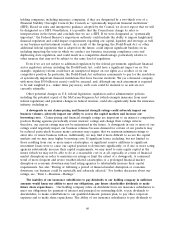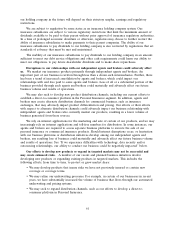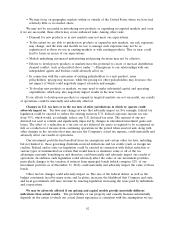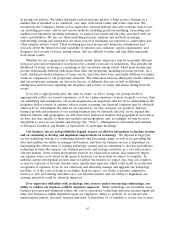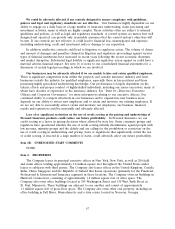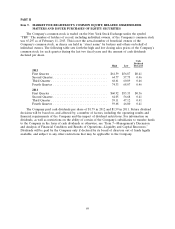Travelers 2012 Annual Report Download - page 71
Download and view the complete annual report
Please find page 71 of the 2012 Travelers annual report below. You can navigate through the pages in the report by either clicking on the pages listed below, or by using the keyword search tool below to find specific information within the annual report.In accordance with industry practice, when policyholders purchase insurance policies from us
through independent agents and brokers, the premiums relating to those policies are often paid to the
agents and brokers for payment to us. In most jurisdictions, the premiums will be deemed to have been
paid to us whether or not they are actually received by us. Consequently, we assume a degree of credit
risk associated with amounts due from independent agents and brokers.
To a large degree, the credit risk we face is a function of the economy; accordingly, we face a
greater risk in an economic downturn. While we attempt to manage the risks discussed above through
underwriting and investment guidelines, collateral requirements and other oversight mechanisms, our
efforts may not be successful. For example, collateral obtained may subsequently have little or no value.
As a result, our exposure to the above credit risks could materially and adversely affect our results of
operations.
Within the United States, our businesses are heavily regulated by the states in which we conduct
business, including licensing and supervision, and changes in regulation may reduce our profitability
and limit our growth. These regulatory systems are generally designed to protect the interests of
policyholders, and not necessarily the interests of insurers, their shareholders and other investors. For
example, to protect policyholders whose insurance company becomes financially insolvent, guaranty
funds have been established in all 50 states to pay the covered claims of policyholders in the event of
an insolvency of an insurer, subject to applicable state limits. The funding of guaranty funds is provided
through assessments levied against remaining insurers in the marketplace. As a result, the insolvency of
one or more insurance companies could result in additional assessments levied against us.
These regulatory systems also address authorization for lines of business, policyholders’ surplus
requirements, limitations on the types and amounts of certain investments, underwriting limitations,
transactions with affiliates, dividend limitations, changes in control, premium rates and a variety of
other financial and non-financial components of an insurer’s business.
In recent years, the state insurance regulatory framework has come under increased scrutiny, and
some state legislatures have considered or enacted laws that may alter or increase state authority to
regulate insurance companies and insurance holding companies. Further, the NAIC and state insurance
regulators continually reexamine existing laws and regulations, specifically focusing on modifications to
holding company regulations, interpretations of existing laws and the development of new laws and
regulations. In a time of financial uncertainty or a prolonged economic downturn or otherwise,
regulators may choose to adopt more restrictive insurance laws and regulations. For example, insurance
regulators may choose to restrict the ability of insurance subsidiaries to make payments to their parent
companies or reject rate increases due to the economic environment. The state insurance regulators
may also increase the statutory capital requirements for our insurance subsidiaries.
In addition, state tax laws that specifically impact the insurance industry, such as premium taxes or
other taxes, may be enacted or changed by states to raise revenues.
State laws or regulations that are adopted or amended may be more restrictive than current laws
or regulations and may result in lower revenues and/or higher costs of compliance and thus could
materially and adversely affect our results of operations and limit our growth.
Changes in federal regulation could impose significant burdens on us and otherwise adversely
impact our results. While the U.S. federal government has not historically regulated the insurance
business, in 2010 the Dodd-Frank Wall Street Reform and Consumer Protection Act (the Dodd-Frank
Act) established a Federal Insurance Office within the U.S. Department of the Treasury. The Federal
Insurance Office has limited regulatory authority and is empowered to gather data and information
regarding the insurance industry and insurers, including conducting a study for submission to the U.S.
Congress on how to modernize and improve insurance regulation in the U.S. Further, the Dodd-Frank
Act gives the Federal Reserve supervisory authority over a number of nonbank financial services
59


